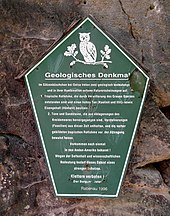Idols
The Götzenbüschchen (also: Götzenbusch) is a wooded hill near Oelsa in the Eastern Ore Mountains . The area consists of sandstones from the Cretaceous Period and is under state protection as a natural monument due to its special geology .
Surname
Before Christianization in the 10th century, the Slavic deity Püstritz (see Bystritza ) was worshiped here. According to the chronicler Schmelz , the toponyms of the nearby Weißeritz river , the places Pesterwitz, Possendorf and the Poisenwald are associated with his name . The stone idol of Püstritz is said to have stood in the idol bush, which is said to have been removed in 1068 on the instructions of Bishop Benno von Meißen .
Location and surroundings
The Götzenbüschchen is located about 700 m west of Oelsa on an inconspicuous ridge, the highest point of which is 361.3 m above sea level. NN is. The sandstone cliffs extend over a length of about 350 m and a width of about 60 to 120 m. The natural monument is located on private property in the Großoelsa district and may not be entered. During a hike, however, you get a good insight into the situation.
geology
The peculiarity of the Götzenbüschchens is the occurrence of a Cretaceous ashlar sandstone, as it is also known from the Elbe Sandstone Mountains and large areas of northern Bohemia . The Götzenbüschchen thus belongs to a number of other sandstone deposits in the Eastern Ore Mountains, such as the Dippoldiswalder Heide , the Hirschbacher Heide and the Paulsdorfer Heide , which have escaped removal. Finds of Inoceramus pictus are remarkable . Are on the west side lying weathered strong gneisses open-minded. The violet-red color and the exposure ratios several meters thick indicate that they were already subject to laterite weathering under subtropical conditions before the Cretaceous period .
Worth seeing
In the direction of Rabenau, at the end of the rocks, there is the former Grünes Waldschlößschen restaurant , which was opened in 1877 and is now used as an apartment. The buildings date from the 17th and 19th centuries and were part of a courtyard. The restaurant had a cellar carved into the rock, which is located near the Waldschlößchen. During the war, the cellar served as an air raid shelter, which included a guard post located between the rocks. For the extraction of sandstone, several sandstone quarries were set up in the 19th century, which are now closed. The bicycle path that passes by is an old trade route that led to Bohemia.
literature
- Between Tharandt forest, Freital and the Lockwitztal (= values of our homeland . Volume 21). 1st edition. Akademie Verlag, Berlin 1973, p. 129.
- Adolf Hanle: Idols . In: Erzgebirge (= Meyer's nature guide ). Meyers Lexikonverlag, Mannheim a. a. 1992, p. 55-56 .
Individual evidence
- ↑ Worth seeing. Stone knife and wolf pillar. Retrieved February 19, 2016 .
- ↑ Kurt Pietzsch : Weathering phenomena of the support surface of the Saxon cenomans . In: Journal of the German Geological Society . tape 65 , 1913, pp. 594-602 ( PDF, 525 kB ).
Web links
- Götzenbüschchen (nature guide Eastern Ore Mountains). Retrieved April 14, 2014 .
- Historical picture of the quarry
Coordinates: 50 ° 56 ′ 54 ″ N , 13 ° 39 ′ 23 ″ E



